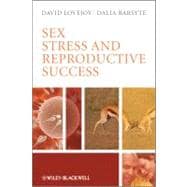
Note: Supplemental materials are not guaranteed with Rental or Used book purchases.
Purchase Benefits
Looking to rent a book? Rent Sex, Stress and Reproductive Success [ISBN: 9780470721391] for the semester, quarter, and short term or search our site for other textbooks by Lovejoy, David A.; Barsyte, Dalia. Renting a textbook can save you up to 90% from the cost of buying.
Dalia Barsyte Protagenic Therapeutics Canada Inc., Canada
Preface.
Acknowledgements.
1 Reproduction Under Safe Conditions.
1.1 Introduction.
1.2 What is Stress?
1.3 Reproduction and Stress.
1.4 Reproduction, Stress and Energy are Intrinsically Interrelated.
1.5 Interaction of Stress and Reproduction.
1.6 Evolution of Germ Cells.
1.7 Variations in Reproductive Strategies.
1.8 Evolution and Complexity.
1.9 Summary.
2 Reproductive Physiology: How is it All Supposed to Work Together?
2.1 Introduction.
2.2 Neurological Regulation of Reproduction.
2.3 Reproductive Cycles.
2.4 Neurological Regulation of Reproduction.
2.5 Summary.
3 The Physiology of Stress: Why Too Much Stress Stops Us from Doing Things We Enjoy.
3.1 Introduction.
3.2 Anxiety and the Evolution of the Stress Response.
3.3 Stress, Anxiety and the Nervous System.
3.4 Autonomic Nervous System.
3.5 Complementary Physiological Systems.
3.6 Integration of HPA/I Components with Other Systems.
3.7 Prolactin and Stress.
3.8 Summary.
4 Reproductive and Stress-associated Behaviours: Integrating Differing Needs.
4.1 Introduction.
4.2 An Integrated Approach to Behavioural Modulation.
4.3 Stress and the Modulation of Learning and Behaviour.
4.4 Summary.
5 Animals Under Strain: Life is Stressful.
5.1 Introduction.
5.2 Changing Environments and Stress Bottlenecks.
5.3 Environmental Stress-Inducing Factors.
5.4 Migration as Part of a Life Strategy.
5.5 Reproductive Strategy and Habitat Erosion.
5.6 Human Industrial Waste as an Evolutionarily Novel Stressor.
5.7 Anticipation of Stress.
5.8 Nutrition, Toxins and Infertility.
5.9 Summary.
6 Saving Women and Children First: Protecting the Progeny.
6.1 Introduction.
6.2 Sexual Selection Costs and Stress.
6.3 Male–Male Interaction Stressors.
6.4 Summary.
7 Epigenetic Factors in Reproductive Success: Don't Ignore Your Parents.
7.1 Introduction.
7.2 Epigenetic Actions of Stress on Reproduction.
7.3 Environmental Effects on Epigenetic Regulation.
7.4 Summary.
8 Species in Captivity: Stress in Agriculture and Aquaculture and Effects on Habitat Loss.
8.1 Introduction.
8.2 Management of Wild Species.
8.3 Species in Captivity.
8.4 Summary.
9 A Cellular Understanding of Stress and its Relationship to Reproduction.
9.1 Introduction.
9.2 Evolution of Cell Stress, Defence and Reproduction.
9.3 Understanding Cell Death.
9.4 Cell Death and Differentiation in Reproductive Development.
9.5 Molecular Mechanisms of Cell Death.
9.6 Heat Shock Proteins in stress and reproduction.
9.7 Relationship between Cell Division and Stress Pathways.
9.8 Summary.
10 Stress and Reproduction in Human Society: Implications for the Twenty-First Century.
10.1 Introduction.
10.2 The Unique Biology of Humans.
10.3 Stressors in Human Society.
10.4 Living with Stress.
10.5 Summary.
Bibliography.
Glossary.
Index.
The New copy of this book will include any supplemental materials advertised. Please check the title of the book to determine if it should include any access cards, study guides, lab manuals, CDs, etc.
The Used, Rental and eBook copies of this book are not guaranteed to include any supplemental materials. Typically, only the book itself is included. This is true even if the title states it includes any access cards, study guides, lab manuals, CDs, etc.